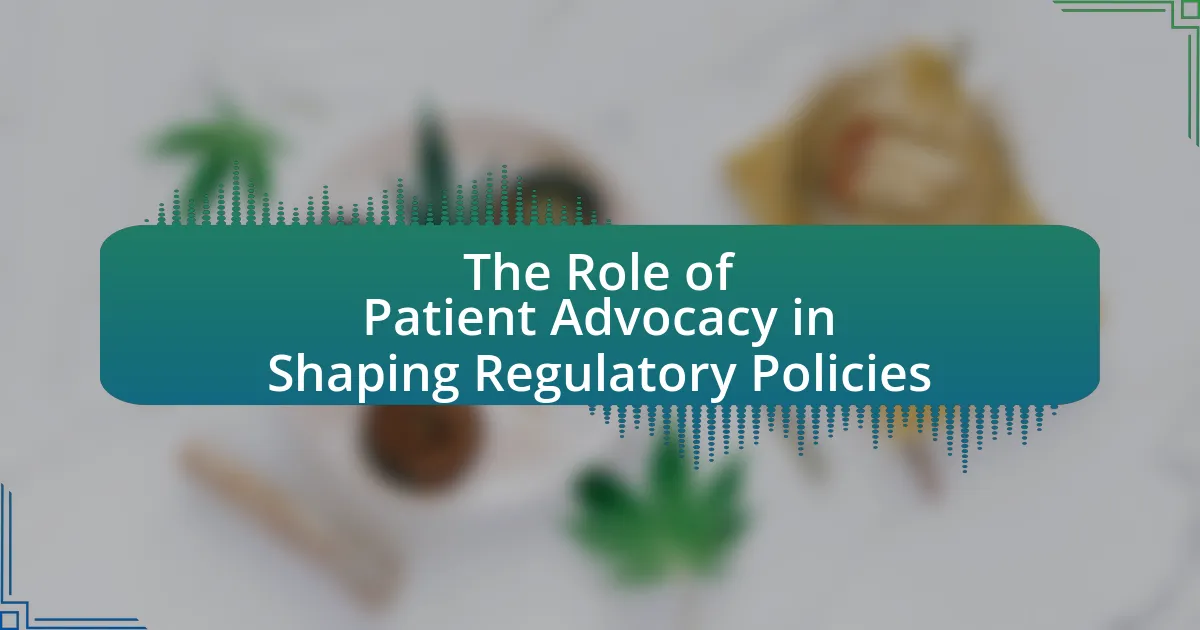The article focuses on the regulatory challenges faced in the manufacturing of gene therapies, highlighting the stringent safety and efficacy standards set by regulatory bodies such as the FDA and EMA. It discusses the complexities of compliance, including the need for consistent manufacturing processes, quality control measures, and extensive preclinical and clinical testing. The article also examines the implications of regulatory hurdles on innovation, development timelines, and the overall landscape of gene therapy, emphasizing the importance of proactive engagement with regulatory agencies and the implementation of best practices to navigate these challenges effectively. Key obstacles, such as high compliance costs and the necessity for specialized expertise, are also addressed, along with strategies for manufacturers to enhance compliance and expedite the regulatory process.

What are the Regulatory Challenges in Manufacturing Gene Therapies?
Regulatory challenges in manufacturing gene therapies include ensuring compliance with stringent safety and efficacy standards set by regulatory bodies such as the FDA and EMA. These challenges arise from the complexity of gene therapy products, which often involve novel technologies and require extensive preclinical and clinical testing to demonstrate their safety and effectiveness. For instance, the FDA mandates a rigorous review process that includes Investigational New Drug (IND) applications and Biologics License Applications (BLA), which can be time-consuming and resource-intensive. Additionally, the need for consistent manufacturing processes and quality control measures complicates compliance, as gene therapies must be produced in a highly controlled environment to prevent contamination and ensure product integrity. The evolving nature of gene therapy technologies further complicates regulatory frameworks, as existing guidelines may not adequately address new methodologies or delivery systems.
Why is regulation critical in the gene therapy manufacturing process?
Regulation is critical in the gene therapy manufacturing process to ensure safety, efficacy, and quality of the therapies produced. Regulatory frameworks, such as those established by the FDA and EMA, mandate rigorous testing and validation protocols that help prevent adverse effects and ensure that gene therapies perform as intended. For instance, adherence to Good Manufacturing Practices (GMP) is required to maintain consistent product quality and minimize contamination risks. These regulations are essential in protecting patients and maintaining public trust in innovative treatments, as evidenced by the stringent approval processes that have led to successful gene therapies like Luxturna, which treats a rare genetic eye disorder.
What specific regulations govern gene therapy manufacturing?
The specific regulations governing gene therapy manufacturing include the U.S. Food and Drug Administration (FDA) regulations, particularly the 21 CFR Part 1271, which outlines the requirements for human cells, tissues, and cellular and tissue-based products. Additionally, the FDA’s guidance documents, such as “Guidance for Industry: Gene Therapy Clinical Trials” and “Guidance for Industry: Chemistry, Manufacturing, and Controls (CMC) for Gene Therapy Products,” provide detailed standards for the development and manufacturing processes. These regulations ensure the safety, efficacy, and quality of gene therapies, as evidenced by the FDA’s rigorous review process for investigational new drug applications (INDs) and biologics license applications (BLAs).
How do regulatory frameworks differ across regions?
Regulatory frameworks differ across regions primarily in their approaches to safety, efficacy, and approval processes for gene therapies. For instance, the United States employs a more flexible and expedited pathway through the FDA, allowing for faster access to innovative therapies, while the European Union follows a more stringent and comprehensive evaluation process through the EMA, which emphasizes long-term safety and efficacy data. Additionally, countries like Japan have implemented unique frameworks, such as the Sakigake designation, to promote the development of advanced therapies. These differences impact the speed of market entry and the overall landscape for gene therapy development, as evidenced by the varying approval timelines and requirements for clinical trials in these regions.
What are the key obstacles faced by manufacturers in compliance?
Manufacturers in the gene therapy sector face several key obstacles in compliance, primarily including complex regulatory frameworks, high costs of compliance, and the need for specialized expertise. The complexity arises from varying regulations across different regions, which can lead to confusion and increased administrative burdens. High compliance costs are driven by the need for extensive testing, documentation, and quality assurance processes, which can strain resources, especially for smaller manufacturers. Additionally, the specialized expertise required to navigate these regulations and ensure adherence to safety and efficacy standards is often scarce, making it difficult for manufacturers to maintain compliance effectively.
How do manufacturing processes impact regulatory compliance?
Manufacturing processes significantly impact regulatory compliance by determining the quality, safety, and efficacy of gene therapies. Regulatory bodies, such as the FDA and EMA, require strict adherence to Good Manufacturing Practices (GMP) to ensure that products meet established standards. For instance, the use of validated processes and quality control measures during manufacturing can prevent contamination and ensure consistent product quality, which is essential for regulatory approval. Non-compliance with these manufacturing standards can lead to product recalls, fines, or delays in market entry, as evidenced by the FDA’s enforcement actions against companies that fail to meet GMP requirements. Thus, the design and execution of manufacturing processes are critical for achieving and maintaining regulatory compliance in the gene therapy sector.
What role does documentation play in meeting regulatory standards?
Documentation is essential in meeting regulatory standards as it provides a comprehensive record of compliance with laws and guidelines. Regulatory bodies, such as the FDA, require detailed documentation to ensure that manufacturing processes adhere to safety, efficacy, and quality standards. For instance, the FDA mandates that gene therapy manufacturers maintain accurate records of production, testing, and quality control to demonstrate compliance with Good Manufacturing Practices (GMP). This documentation serves as evidence during inspections and audits, facilitating transparency and accountability in the manufacturing process.
How do regulatory challenges affect the development timeline of gene therapies?
Regulatory challenges significantly extend the development timeline of gene therapies by introducing complex approval processes and stringent compliance requirements. These challenges often lead to delays in clinical trial initiation, as developers must navigate extensive documentation, safety assessments, and efficacy evaluations mandated by regulatory bodies such as the FDA and EMA. For instance, the FDA’s requirement for a comprehensive Investigational New Drug (IND) application can take several months to prepare and review, impacting the overall timeline. Additionally, the evolving nature of gene therapy regulations, which are still being established, can create uncertainty and necessitate additional studies or modifications to existing protocols, further prolonging the development process.
What are the implications of delays in regulatory approval?
Delays in regulatory approval can significantly hinder the timely introduction of gene therapies to the market. Such delays can lead to increased costs for manufacturers, as they may incur additional expenses related to extended clinical trials, compliance measures, and operational adjustments. For instance, a study by the Tufts Center for the Study of Drug Development found that delays in the approval process can increase the overall development costs of new therapies by up to 30%. Furthermore, these delays can negatively impact patient access to potentially life-saving treatments, prolonging the duration of unmet medical needs. Additionally, prolonged regulatory timelines can diminish the competitive advantage for companies, as they may lose market share to faster-moving competitors.
How can manufacturers expedite the regulatory process?
Manufacturers can expedite the regulatory process by implementing proactive engagement strategies with regulatory agencies. This includes early and continuous communication with agencies like the FDA or EMA, which allows manufacturers to clarify requirements and address potential issues before formal submissions. For instance, the FDA’s “Breakthrough Therapy” designation facilitates faster development and review processes for therapies that treat serious conditions, demonstrating that timely interaction can significantly reduce approval times. Additionally, utilizing regulatory science frameworks and guidance documents can help manufacturers align their development processes with regulatory expectations, further streamlining the approval pathway.

What are the Impacts of Regulatory Challenges on Innovation in Gene Therapies?
Regulatory challenges significantly hinder innovation in gene therapies by imposing lengthy approval processes and stringent compliance requirements. These challenges can delay the introduction of new therapies, as seen in the case of the U.S. Food and Drug Administration (FDA) requiring extensive clinical trials that can take years to complete. For instance, the FDA’s rigorous standards for safety and efficacy can lead to increased costs and resource allocation towards meeting regulatory demands rather than focusing on research and development. Additionally, uncertainty in regulatory frameworks can deter investment in gene therapy projects, as companies may be reluctant to commit resources without clear guidelines. This combination of delays, increased costs, and investment hesitancy ultimately stifles the pace of innovation in the field.
How do regulatory hurdles influence research and development?
Regulatory hurdles significantly delay research and development by imposing stringent compliance requirements that must be met before advancing projects. These regulations often necessitate extensive documentation, clinical trials, and safety assessments, which can prolong timelines and increase costs. For instance, the U.S. Food and Drug Administration (FDA) mandates rigorous testing protocols for gene therapies, leading to an average development time of over 10 years and costs exceeding $1 billion. This regulatory landscape can deter investment and innovation, as companies may prioritize projects with clearer pathways to market approval.
What are the effects of stringent regulations on innovation rates?
Stringent regulations typically hinder innovation rates by increasing compliance costs and extending development timelines. For instance, the pharmaceutical industry often faces lengthy approval processes, which can delay the introduction of new therapies. A study by the National Bureau of Economic Research found that stringent regulatory environments can reduce the number of new drug approvals, thereby stifling innovation. Additionally, the complexity of regulatory requirements can divert resources away from research and development, further impacting the pace of innovation in fields like gene therapy.
How can manufacturers balance compliance with innovation?
Manufacturers can balance compliance with innovation by integrating regulatory considerations into the early stages of the product development process. This proactive approach allows manufacturers to design products that meet regulatory standards while fostering innovative solutions. For instance, the FDA’s guidance on gene therapy emphasizes the importance of risk assessment and management, which can be incorporated into the innovation process to ensure compliance without stifling creativity. By adopting a framework that aligns regulatory requirements with innovative practices, manufacturers can streamline their processes, reduce time to market, and enhance product safety and efficacy.
What strategies can be employed to navigate regulatory challenges?
To navigate regulatory challenges in manufacturing gene therapies, companies can implement a proactive compliance strategy. This involves engaging with regulatory agencies early in the development process to clarify requirements and expectations, which can significantly reduce the risk of non-compliance. For instance, the FDA encourages pre-IND (Investigational New Drug) meetings, allowing developers to discuss their plans and receive guidance, thereby streamlining the approval process. Additionally, maintaining thorough documentation and quality control throughout the manufacturing process ensures adherence to Good Manufacturing Practices (GMP), which is critical for regulatory approval. According to a study published in the journal “Nature Biotechnology,” companies that adopt a collaborative approach with regulators experience faster approval times and fewer compliance issues.
How can collaboration with regulatory bodies facilitate smoother processes?
Collaboration with regulatory bodies can facilitate smoother processes by ensuring that manufacturers of gene therapies align their practices with regulatory expectations from the outset. This proactive engagement allows for the identification and resolution of potential compliance issues early in the development process, reducing delays in approvals. For instance, the FDA’s guidance on gene therapy development encourages early dialogue between sponsors and regulators, which has been shown to expedite the review process and enhance the quality of submissions. Historical data indicates that companies that engage in such collaboration often experience shorter timelines for product approvals, as seen in the expedited pathways established for breakthrough therapies.
What role does early engagement with regulators play in development?
Early engagement with regulators plays a crucial role in the development of gene therapies by facilitating a clearer understanding of regulatory requirements and expectations. This proactive approach allows developers to align their research and development processes with regulatory standards, reducing the risk of delays and costly modifications later in the process. For instance, the FDA’s guidance on gene therapy emphasizes the importance of early communication to address potential safety and efficacy concerns, which can streamline the approval process and enhance the likelihood of successful market entry.

What Best Practices Can Help Overcome Regulatory Challenges in Gene Therapy Manufacturing?
Best practices to overcome regulatory challenges in gene therapy manufacturing include implementing robust quality management systems, ensuring compliance with Good Manufacturing Practices (GMP), and engaging in early and continuous dialogue with regulatory agencies. A robust quality management system helps maintain product consistency and safety, which is critical given the complex nature of gene therapies. Compliance with GMP ensures that manufacturing processes meet stringent safety and quality standards, as evidenced by the FDA’s emphasis on these practices in their guidance documents. Early engagement with regulatory agencies, such as the FDA or EMA, facilitates understanding of regulatory expectations and can streamline the approval process, as demonstrated by successful cases where companies received expedited pathways for innovative therapies.
What are the essential steps for ensuring compliance in manufacturing?
The essential steps for ensuring compliance in manufacturing include establishing a robust quality management system, conducting regular audits, training personnel, and adhering to regulatory guidelines. A quality management system ensures that processes meet industry standards, while regular audits help identify and rectify non-compliance issues. Training personnel is crucial for maintaining awareness of compliance requirements, and adherence to regulatory guidelines, such as those set by the FDA or EMA, is necessary to meet legal obligations. These steps collectively help mitigate risks associated with manufacturing gene therapies, which are subject to stringent regulations due to their complexity and potential impact on patient safety.
How can manufacturers implement quality management systems effectively?
Manufacturers can implement quality management systems effectively by adopting a structured approach that includes defining clear quality objectives, engaging in continuous training, and utilizing data-driven decision-making. Establishing specific quality objectives aligns the organization’s goals with regulatory requirements, ensuring compliance with standards such as ISO 9001, which emphasizes customer satisfaction and process improvement. Continuous training of personnel enhances their understanding of quality protocols and regulatory expectations, which is crucial in the highly regulated field of gene therapy manufacturing. Furthermore, employing data-driven decision-making allows manufacturers to analyze performance metrics and identify areas for improvement, thereby fostering a culture of quality and compliance. This approach is supported by the FDA’s guidance on quality systems, which highlights the importance of a systematic framework in maintaining product quality and safety in gene therapies.
What training and resources are necessary for staff involved in compliance?
Staff involved in compliance require specialized training in regulatory standards, quality assurance, and risk management specific to gene therapy manufacturing. This training typically includes understanding Good Manufacturing Practices (GMP), regulatory guidelines from agencies like the FDA and EMA, and the ethical considerations surrounding gene therapies. Resources necessary for effective compliance include access to updated regulatory documentation, compliance management software, and ongoing professional development opportunities such as workshops and seminars. These elements ensure that staff remain informed about the latest regulatory changes and best practices, which is critical for maintaining compliance in the highly regulated field of gene therapy.
How can manufacturers stay updated on regulatory changes?
Manufacturers can stay updated on regulatory changes by actively engaging with regulatory agencies, subscribing to industry newsletters, and participating in professional organizations. Engaging with agencies like the FDA or EMA allows manufacturers to receive direct updates on new regulations and guidelines. Subscribing to newsletters from organizations such as the Regulatory Affairs Professionals Society provides timely information on regulatory developments. Additionally, participation in professional organizations facilitates networking and information sharing among peers, which can highlight emerging regulatory trends and changes. These methods ensure that manufacturers remain informed and compliant with evolving regulations in the gene therapy sector.
What resources are available for tracking regulatory updates?
Resources available for tracking regulatory updates include government websites, industry associations, and specialized regulatory databases. Government websites such as the U.S. Food and Drug Administration (FDA) and the European Medicines Agency (EMA) provide official updates on regulations and guidance documents. Industry associations like the Biotechnology Innovation Organization (BIO) and the Pharmaceutical Research and Manufacturers of America (PhRMA) offer insights and summaries of regulatory changes relevant to gene therapies. Additionally, specialized databases such as Regulatory Affairs Professionals Society (RAPS) and LexisNexis provide comprehensive tracking tools and alerts for regulatory developments. These resources are essential for staying informed about the evolving regulatory landscape in gene therapy manufacturing.
How can networking with industry peers aid in compliance efforts?
Networking with industry peers can significantly enhance compliance efforts by facilitating the sharing of best practices and insights regarding regulatory requirements. When professionals in the gene therapy manufacturing sector connect, they can exchange information about successful compliance strategies, recent regulatory changes, and common challenges faced in the industry. This collaborative environment fosters a culture of continuous improvement and innovation, which is crucial for adhering to complex regulations. For instance, organizations that participate in industry associations often gain access to exclusive resources, training, and workshops that are tailored to current compliance issues, thereby improving their operational standards and reducing the risk of non-compliance.
What practical tips can manufacturers follow to enhance compliance?
Manufacturers can enhance compliance by implementing a robust quality management system (QMS) that aligns with regulatory standards. A well-structured QMS ensures that all processes, from raw material sourcing to final product testing, adhere to guidelines set by regulatory bodies such as the FDA and EMA. Regular training for staff on compliance requirements is essential, as it keeps the workforce informed about the latest regulations and best practices. Additionally, conducting internal audits and risk assessments can identify potential compliance gaps, allowing manufacturers to address issues proactively. According to a study published in the Journal of Gene Therapy, companies that adopt comprehensive compliance strategies experience a 30% reduction in regulatory non-conformities, demonstrating the effectiveness of these practices in maintaining adherence to regulatory standards.




